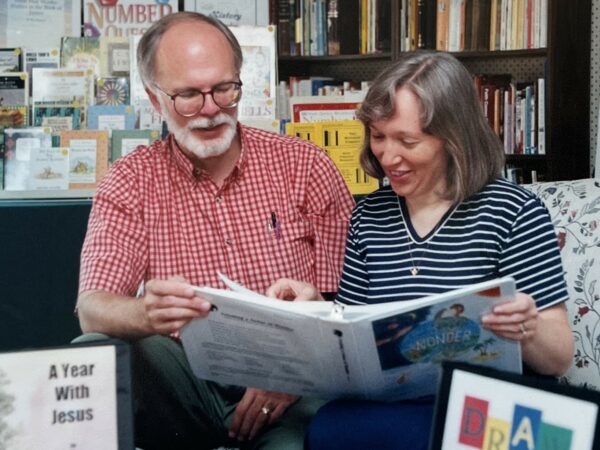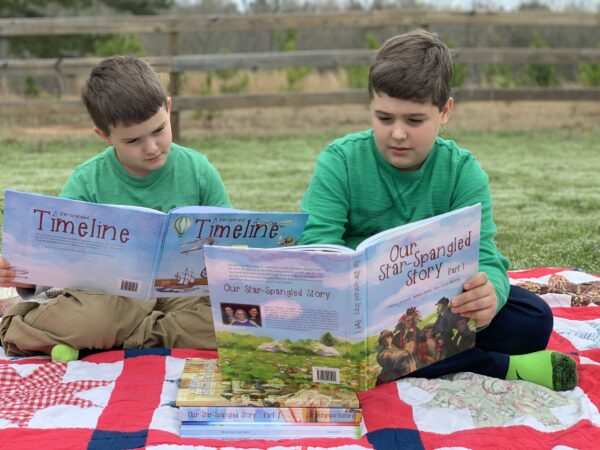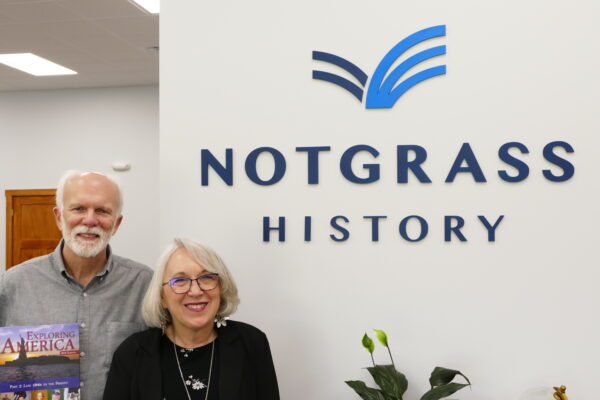Notgrass History and God’s Faithfulness, Part 4: 2018-The Present
In the early 1990s, while teaching in a first and second grade Sunday School class, I thought about the fact that we never seemed to spend enough time teaching about Creation, so I decided to devote the next six months to that subject.
I made a list of Creation topics for the next 26 weeks and put them in the order of the Creation week, decorated the classroom with posters illustrating verses about Creation, hung paper birds and clouds from the ceiling, and lined the window ledge with books from the public library that showed the wonders of what God had made.
Our class had few girls and lots of little boys. On the first Sunday of our study, several boys arrived first and sat down at the table. One of them said, “This room looks different from the way it did last week.”
I said, “Yes. What do you think we are going to study?”
One little boy said, “The universe?”
I said, “Well . . . sort of. We are going to study about all the things that God made.”
Another boy said, “God didn’t make the universe, did He?”
My jaw dropped and so did the other teacher’s. We knew this little boy. He was from a godly home and came to church all the time. He wasn’t a troublemaker. I was confident that in his seven years of coming to church he had heard that God made the world. Realizing that the room looked more like a schoolroom than a Sunday School room, I wondered, “Has he been listening to what he hears at school and on the Discovery Channel and put that in one compartment and what he has learned at Sunday School in another?”
A six-month study and a little boy’s question spurred a lifelong passion in me. Though no longer in print, the first homeschool curriculum I ever wrote was about God’s creation. It is what Ray and I are looking at in this picture.

That long ago conversation in a Sunday School classroom and that first curriculum has inspired many of the beautiful pictures of God’s creation that are in our books. They have inspired the God’s Wonders lessons in our middle school American and world histories. All history, geography, government, economics, and civics are possible because God made the world and the people who have lived in it since He made it.
Scope and Sequence. As we added new curriculum to what we offer, we thought a great deal about our scope and sequence for a student using Notgrass History for all 12 years. We made plans eventually to publish an American history, a world history, a world geography, and a civics/government/economics type of course for elementary, middle school, and high school, believing that students would benefit from covering those broad topics three times and on three levels during their homeschooling.
We decided to emphasize key concepts at each level so that a subsequent course would serve as both a review and a source of more in-depth information about those concepts. In each course we would also add additional people and events that were unique to that level, always keeping in mind the maturity level of the student. We would also cover additional world and American history topics in the geography and civics/government/economics courses.
Our Star-Spangled Story. In 2018 we published our first history curriculum for elementary students. Our daughters, Bethany and Mary Evelyn, homeschooling mothers themselves, and I collaborated on an American history entitled Our Star-Spangled Story. The curriculum is a chronological study of American history with lessons chosen specifically for younger students. It has 30 units with three lessons each. Like our middle school curriculum, each unit has a suggested family activity and, like all of our curriculum, we suggest literature to go along with the lessons.

For the first time, we published a full-color hardback timeline called Our Star-Spangled Timeline. We chose songs, poetry, and folk dances as the primary sources and published them in a book entitled Star-Spangled Rhythms and Rhymes. Homeschool students, graduates, and parents recorded the songs and poems. We made videos to teach students how to do the folk dances. All of these are available online. The curriculum set also includes a Student Workbook.
Exploring World Geography. In 2020 we published Ray’s Exploring World Geography, which completes our offerings for the four years of high school. The curriculum includes a full-color gazetteer featuring maps and details about the countries of the world plus primary source documents. Daily lessons guide students on a journey across our planet, focusing on how people interact with the physical world around them. Like our other high school courses, weekly project ideas include a choice of writing assignments and other creative activities. The curriculum focuses on developing a Christian worldview and, like all of our courses, we recommend specific literature titles.

Our 50 States. Also in 2020, we published Our 50 States for elementary students, written and developed by our daughter Mary Evelyn. The one-year course has 104 lessons divided into 26 units of four lessons each. It has two lessons on each state, two lessons about Washington, D.C., and two about U.S. overseas territories. The course includes a hardback textbook with lessons to read, song lyrics to a song for each state, and instructions for family activities. Students complete an Atlas Workbook. The curriculum also has a Lesson Review.

Another New Office. In 2022 Notgrass History moved away from Ray’s and my home into our first off-site headquarters. Some of our team members work in the office and warehouse, while others work remotely. Without our amazing team, our company could not ship orders, answer customer questions, make videos, design graphics, attend conferences, and continue developing curriculum!

Mary Evelyn is now writing and developing an elementary world geography, entitled Our Great Big World, which has a similar format to Our 50 States. I am now working on a world history for elementary students. When we finish those two projects and a world geography for middle school, our twelve years will be complete. Lest your wonder if we’ll have anything to do after that, don’t worry. I haven’t mentioned the multiple updates that we have already needed to complete over the last 25 years. History keeps happening, so every few years there is another update to complete.
Around 1704, Benjamin Schmolck published Mein Jesu, Wie Du Willt. In 1854 Jane L. Borthwick translated it from German into English. Here is the last verse.
My Jesus, as Thou wilt! All shall be well for me;
Each changing future scene I gladly trust with Thee:
Straight to my home above I travel calmly on,
And sing, in life or death, my Lord, Thy will be done!
We can trust God with the “changing future scenes” in history, and we can trust the changing future scenes in our lives. Teaching our children that they can trust God with each changing future scene is one of the most important lessons you will ever teach them.
Though the fig tree should not blossom
And there be no fruit on the vines,
Though the yield of the olive should fail
And the fields produce no food,
Though the flock should be cut off from the fold
And there be no cattle in the stalls,
Yet I will exult in the Lord,
I will rejoice in the God of my salvation.
The Lord God is my strength,
And He has made my feet like hinds’ feet,
And makes me walk on my high places.
Habakkuk 3:17-19

